BONOS DE CARBONO REDD+ : TERMINAN CONTROLANDO EL CARBONO, LOS BOSQUES, LA PROPIEDAD INTELECTUAL Y HASTA LA FORMA DE VIDA DE LOS MATSÉS
"El mecanismo REDD+ puede ser conducido a escenarios de falsas soluciones a la agresión climática global, que darán ganancias en juegos especulativos financieros, pero que no va impedir llegar al límite de más de 3°C de temperatura global donde los desastres climáticos y ambientales serán irreversibles" afirma categoricamente AIDESEP y también CONACAMI.
---------------------------------
PÉSIMO PRECEDENTE
“Sustainable Carbon Resources Limited” representada por el australiano David John Nilsson, está dividiendo y presionando al Pueblo Matsés, PARA QUE FIRME CONTRATO DE BUSINESS DE CARBONO en el cual LOS MATSÉS aportan 420,000 hectáreas de bosques, dan poder total a una empresa con un capital de apenas $ 10,000 dólares QUE TERMINA CONTROLANDO EL CARBONO, LOS BOSQUES, LA PROPIEDAD INTELECTUAL Y HASTA LA FORMA DE VIDA DE LOS MATSÉS ... y ... que demuestra su mala fe, al obligar a firmar un contrato en inglés, sujeto a leyes y juzgados ingleses, sin plazo de vencimiento, y amenaza con juicios a quienes denuncian esta estafa.
Remote Matses village. Photo courtesy of The Field Museum, R. Foster .
.http://photos.mongabay.com/j/matses-mapa-1.jpg

A member of Matse community in Peru's Amazon Rainforest. (Photo by Anna Kovasna)
-------------------------------------
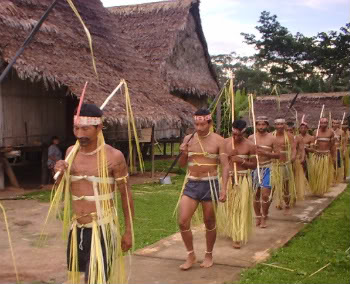
The Matses people in ceremonial dress. Courtesy of The Field Museum, P. Zanabria.
http://photos.mongabay.com/j/matses-mapa-1.jpg

View of rainforest in the new Matses National Reserve. Photo courtesy of The Field Museum, R. Foster. http://photos.mongabay.com/j/matses-mapa-1.jpg
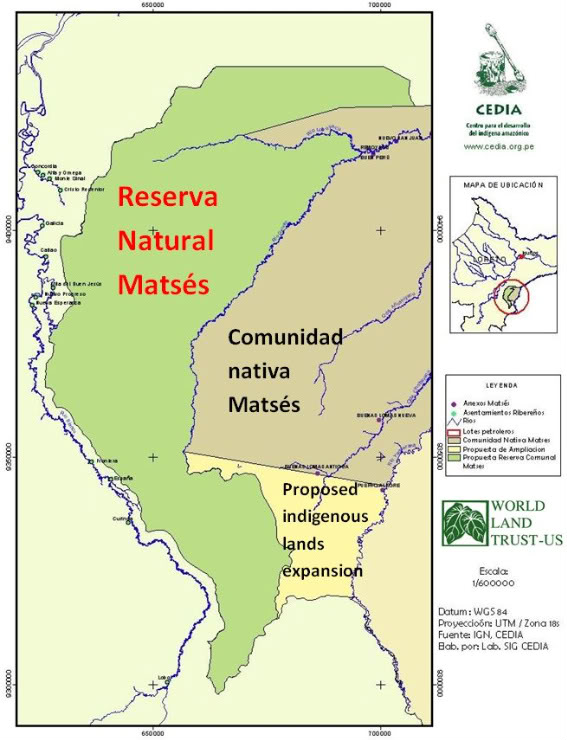
http://photos.mongabay.com/j/matses-mapa-1.jpg
 GOOD FRIEND OF MATSÉS - Pablito, a Matses Indian helped the good teach Benedict to live in Rain Forest, during his crossing of the Amazon Basin. Javari River, Peruvian Amazon. Britain's leading adventurers, Benedict Allen, is particularly known for his television programmes - occasionally made with the help of a film crew but more typically without. He paved the way for the current generation of TV adventurers.
GOOD FRIEND OF MATSÉS - Pablito, a Matses Indian helped the good teach Benedict to live in Rain Forest, during his crossing of the Amazon Basin. Javari River, Peruvian Amazon. Britain's leading adventurers, Benedict Allen, is particularly known for his television programmes - occasionally made with the help of a film crew but more typically without. He paved the way for the current generation of TV adventurers.
-----------------------------------
Los miles de millones de dólares comprometidos para proyectos REDD+ han incentivado la aceleración de reformas en la tenencia de los bosques, la pugna por la propiedad de los bosques. En muchos países en desarrollo no queda claro quiénes poseen las tierras de los bosques – propietarios privados, grupos indígenas, otras comunidades locales o gobiernos nacionales.
“Históricamente, la gente que vive en los bosques ha sido tratada como invasora en sus propios hogares y ha sido privada de obtener una parte justa de los beneficios de los recursos”, subrayó William Sunderlin, Científico Principal del Centro para la Investigación Forestal Internacional (CIFOR). http://www.bionero.org/cambio-climatico/el-gran-reto-de-redd-confusion-sobre-la-tenencia-de-los-bosques
"Con los millones de dólares ofrecidos a países en desarrollo para proteger sus bosques, por su rol en desacelerar el cambio climático, se ha renovado la atención a los dueños de los bosques y sobre quién posee el carbono de los árboles y la tierra" remarca Sunderlin
----------------
No hay Redd+ sin Territorios, Derechos y Autonomía de los Pueblos Indígenas
http://www.aidesep.org.pe/index.php?codnota=2000
AIDESEP, 28 de abril de 2011. Reunidos en la ciudad de Iquitos, las ocho organizaciones regionales, federaciones de los pueblos amazónicos agrupados en la AIDESEP y con la solidaridad de la CONACAMI, denunciaron el peligro de catástrofe y destrucción de la cuenca amazónica, expresada en la irregularidad de las estaciones climáticas, las gigantescas inundaciones, sequías frecuentes, ríos desaparecidos, extinción de especies, desastres naturales, pérdidas agrícolas, aumento de enfermedades.
Los Apus reunidos señalaron que no se trata de un cambio climático natural, sino del calentamiento global producido el modelo de desarrollo que genera agresión climática de los gases contaminantes de los países industrializados y agravada por la deforestación, depredación y contaminación de las industrias extractivas locales, los monocultivos, plantaciones de biocombustibles, grandes hidroeléctricas, y prácticas inadecuadas de subsistencia.
Por eso exigieron la reducción de los gases del calentamiento global, cambiando el modo de vida del sistema económico y social dominante y subrayaron la deuda ecológica histórica de un puñado de países poderosos que usan en promedio mundial 3.8 hectáreas por habitante para el consumismo frente a las mayorías que sobreviven en la pobreza usando 1.4 Ha /Hab. A la vez reconocer el aporte de los pueblos indígenas a la humanidad de mantener vivo este planeta por miles de años y que se quiere destruir en el último siglo.
Por eso alertaron que el proyecto de Reducción de Emisiones por Deforestación y Degradación - Redd+ o el programa de Manejo Sostenible de Recursos, aprobado en la Cumbre de Cancún del 2010 de la Convención del Clima - CMNUCC puede ser conducido a ese escenario de falsas soluciones a la agresión climática global, que darán ganancias en juegos especulativos financieros, pero que no va impedir llegar al límite de más de tres grados de temperatura global donde los desastres climáticos y ambientales serán irreversibles.
Y denunciaron a la empresa de Hong Kong SCRL (“Sustainable Carbon Resources Limited”, representada por el ciudadano de Australia David John Nilsson) que está dividiendo y presionando al Pueblo Matsés, para que firme un contrato de negocios de carbono y en la cual nuestros hermanos aportan 420 mil hectáreas de bosques, dan poder total a una empresa con apenas $ 10,000 que termina controlando el carbono, los bosques, la propiedad intelectual y las formas de vida de los Matsés, y que demuestra su mala fe, al obligar a firmar un contrato en inglés, sujeto a leyes y juzgados ingleses, sin plazo de vencimiento, y amenaza con juicios a quienes denuncian esta estafa.
Por eso, exigieron la intervención del Ministerio Público y la expulsión del Perú de este empresario Nilsson. Esto es un mal ejemplo de la “burbuja Redd” similar a 100 proyectos de estafas en el mundo (Papúa, Indonesia, Congo, etc.) y otros que se intentan hacer de mala fe en Madre de Dios, Amazonas, San Martin, entre otros, donde se atropella derechos de los pueblos indígenas, se busca controlar el bosque y carbono de los territorios indígenas, dividiendo a nuestros pueblos con ilusiones millonarias inexistentes; y los promotores del Redd+ (Estado peruano, Bancos multilaterales, ONU) tienen el deber de intervenir y detener esa “burbuja” y estafas como la señalada.
http://www.aidesep.org.pe/index.php?codnota=2000
 http://reddeenergia.com/noticias/2010/06/30/larepublica.2010.06.30.09.jpg
http://reddeenergia.com/noticias/2010/06/30/larepublica.2010.06.30.09.jpg
----------------------
Declaración de Iquitos
No hay Redd+ sin Territorios, Derechos y Autonomía
de los Pueblos Indígenas
ver en:
http://www.aidesep.org.pe/editor/documentos/1371.pdf
----------------------------------------
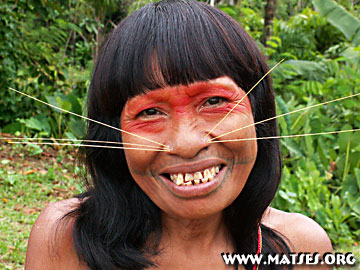 The Matsés people (who are also commonly called Mayorunas in Brazil) are often affectionately referred to as the "cat people" due to the characteristic "whiskers" and facial tattoos. Presently, there are about 2200 Matsés living in the Yavarí Valley of Peru and Brazil, with the majority residing in Peru. The Matsés speak a language of the Panoan linguistic family that is closely aligned with the dialects that the Matis and Korubo Indians speak.
The Matsés people (who are also commonly called Mayorunas in Brazil) are often affectionately referred to as the "cat people" due to the characteristic "whiskers" and facial tattoos. Presently, there are about 2200 Matsés living in the Yavarí Valley of Peru and Brazil, with the majority residing in Peru. The Matsés speak a language of the Panoan linguistic family that is closely aligned with the dialects that the Matis and Korubo Indians speak.
In 1969, the Matsés first made permanent contact with the outside world when they accepted Christian missionaries into their communities. Since then, they have preserved much of the their culture and way of life, still hunting and fishing as their ancestors had for millennia. Most importantly, many communities have retained their unique traditional medicine and knowledge of medicinal plants whose secrets scientists are only now discovering.
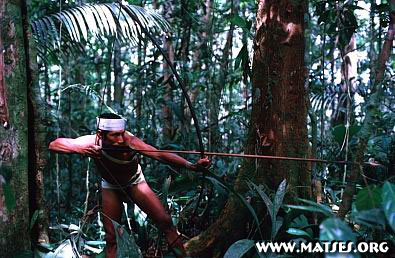 While many other Amazonian tribes use blowguns to hunt, the Matsés are specialists in the use of bows and arrows. Formerly, they were used for war, but presently are only used for hunting game. Arrows measure about two meters in length and very complex workmanship is involved in their manufacture. Matsés arrows are incredible works of art and craftsmanship that illustrate their strong work ethic and allow them to maintain their traditional way of life without dependence on outside society. In contrast, most other indigenous groups use shotguns exclusively, making them dependent on expensive nonrenewable resources such as shotgun shells to hunt.
While many other Amazonian tribes use blowguns to hunt, the Matsés are specialists in the use of bows and arrows. Formerly, they were used for war, but presently are only used for hunting game. Arrows measure about two meters in length and very complex workmanship is involved in their manufacture. Matsés arrows are incredible works of art and craftsmanship that illustrate their strong work ethic and allow them to maintain their traditional way of life without dependence on outside society. In contrast, most other indigenous groups use shotguns exclusively, making them dependent on expensive nonrenewable resources such as shotgun shells to hunt.
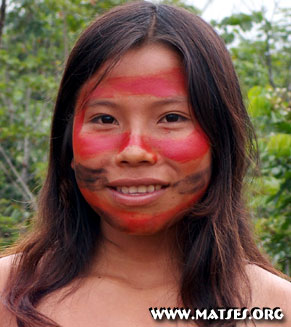 With few exceptions, the Matsés people have no regular economic income, with self-sufficient hunting and fishing being their primary economic activities. Since 1998, the Mats�s have had legal title to their own lands. The Matsés titled lands comprise 452,735 hectares along the Yavarí, Yaquerana, and Gálvez Rivers. At present, no outsiders are extracting resources (timber, game, or fruits) from the land, thus conserving the resources and making a sustainable existence possible.
With few exceptions, the Matsés people have no regular economic income, with self-sufficient hunting and fishing being their primary economic activities. Since 1998, the Mats�s have had legal title to their own lands. The Matsés titled lands comprise 452,735 hectares along the Yavarí, Yaquerana, and Gálvez Rivers. At present, no outsiders are extracting resources (timber, game, or fruits) from the land, thus conserving the resources and making a sustainable existence possible.
Despite the richness of their culture and way of life, the Mats�s people live in extreme poverty with diseases such as malaria and hepatitis extracting an incredible toll in terms of human suffering and mortality. Lack of basic services such as health and education jeopardizes the ability of the Matsés to defend their lands and way of life.
--------------------------------------------
http://pib.socioambiental.org/en/povo/matses/1952
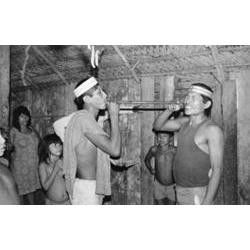
The word matses is polysemic. It can denote the people we know by this name in opposition to others (who are called maiu or matses utsi), any indigenous people in opposition to non-indigenous (called chotac), or ‘people’ in opposition to other beings. Matses may also mean the group of co-residents or kin closest to the speaker, as well as the set of maternal uncles and paternal aunts’ husbands (in this case preceded by the particle cun, indicating possession). In Peru, the word is used as an ethnonym. In Brazil, the Matsés are also known as the Mayoruna.
Mayoruna is a term of Quechua origin (mayu= river; runa= people), used from the 17th century onwards by colonizers and missionaries to refer to groups inhabiting the region formed by the lower Ucayali, the upper Amazon (Solimões) and the Javari (Erikson 1992). From the first documents produced by early missionaries and others colonizing the region until the start of the 20th century, not much can be ascertained about these groups. Lexical comparisons between lists of ‘Mayoruna’ and ‘Maxuruna’ words collected by Castelnau (1851), Martius (1867) and Spix & Martius (1831) and the present-day Matsés indicate the proximity between these languages and the possibility of their belonging to the same subset within the Pano family (Fleck 2003). However this linguistic proximity is not enough for us to attribute any cultural or historical continuity between the Mayoruna of the 19th century travellers and today's Matsés/Mayoruna.
The Matsés are the largest of the current groups belonging to a subset within the Northern Pano (Erikson 1992). This subset also includes the Matis, Kulina-Pano, Maya, Korubo, and possibly other groups who still avoid any permanent contact with non-Indians. As well speaking mutually intelligible languages, these groups share cultural features such as the use of the blowgun, specific hunting techniques, patrilineal moieties and so forth. However beyond the markers of a supposed shared identity, what justifies treating these peoples as a group is the affirmation made by the Matsés themselves that they are closer because they “speak the same language” or recognize these groups as examples “of how our ancestors lived.”
With the exception of the Matsés and Matis, who have been the subject of ethnological studies, we know very little about these peoples, either in terms of their languages or in relation to their cosmologies and social organization. Almost all the population of the Kulina-Pano live in just one village on the Pedro Lopes river, an affluent of the Curuçá. There are also some Kulina-Pano married to Matsés and living among them, mostly in Trinta-e-Um village (on the upper Javari) and Nova Esperança village (on the Pardo river). A small group of 25 Korubo (adults and children) was contacted in 1996 at the confluence of the Ituí and Itacoaí rivers. Funai's Isolated Indians Coordination Team runs a surveillance post, the Vale do Javari Ethno-Environmental Protection Front, close to the site where this group of Korubo lives. The group named Maya (or ‘the isolated Indians of the Quixito’) is currently living in ‘voluntary isolation.'
The Matsés population is significantly more numerous than all the other Northern Pano peoples closest to them linguistically and culturally – a fact explained by the warfare activity undertaken by the Matsés in the last century.
Linguistic situation
The Matsés living in Brazil are mostly monolingual with children raised in the villages being educated exclusively in the indigenous language. Only those people who have worked or studied in the surrounding Peruvian or Brazilian towns speak Portuguese and Spanish fluently.
http://pib.socioambiental.org/en/povo/matses/1952
---------------------------------------------------------

Viernes, 25 de Febrero de 2011 17:05
PRIMER PROYECTO REDD DE CONSERVACIÓN DE BOSQUES EMITE BONOS DE CARBONO
Un proyecto de prevención de deforestación en Kenia se ha convertido en el primero de una veintena de proyectos REDD en todo el mundo para obtener créditos de carbono emitido en el marco del Voluntary Carbon Standard (VCS).
El proyecto desarrollado por Kasigau Wildlf Work ha emitido su primeros 1450 millones de créditos. Se trata de VCUs para la conservación de 200.000 hectáreas de bosques y Sabana amenazados, en los últimos cinco años desde que se inició el proyecto. Alrededor de 1,15 millones de créditos se vendieron a Nedbank Group en Sudáfrica, uno de los primeros sostenedores del proyecto, mientras que casi 300.000 han entrado en una reserva de búfer, un requisito para la certificación de normas para cubrir cualquier pérdida futura de los árboles preservados.
El precio de venta no ha sido revelado. Los brokers de Carbono estiman que el precio de acuerdo a la oferta y demanda actual de VCU REDD fluctúan en el rango de 5 %u20AC y 6,50 %u20AC en el mercado voluntario de carbono. Kevin Nedlands 'Whitfield dijo a Bloomberg que existe una demanda firme de los grandes emisores y operadores financieros en los EE.UU. y Europa para los créditos REDD verificados independientemente del tipo generado por el proyecto Kasigau. Otros 200.000 créditos se esperan al año para el resto de vida de 30 años del proyecto, mientras que otros proyectos en Indonesia y América Latina deben pronto comenzar a generar créditos.
El proyecto busca estándares de certificación más para alcanzar la totalidad de sus beneficios sociales y ambientales reconocidos. A finales de 2009, el proyecto fue validado en el nivel más alto, Gold, del estándar de la Alianza de uso de la tierra , Clima, Comunidad y Biodiversidad por su diseño el cual preserva la fauna africana icónica y la entrega de ingresos sostenibles para la población local.
El director ejecutivo del VCS, David Antonioli describe la emisión como un "momento decisivo" para el mercado de carbono forestal, agregando que "esto es exactamente lo que se necesita para atraer la inversión privada para la protección de los bosques".
Reuters, Bloomberg, 9/2/11
Primer proyecto REDD de consercación de bosques emite bonos de carbono 25 Feb 2011 ... El proyecto desarrollado por Kasigau Wildlf Work ha emitido su ... a la oferta y demanda actual de VCU REDD fluctúan en el rango de 5 %u20AC ...
www.justiciaclimatica.org/index.php?...redd... - En caché



